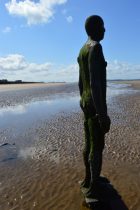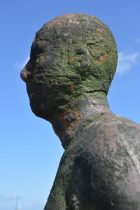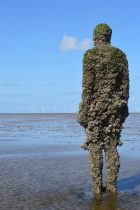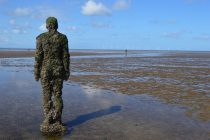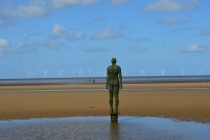100 iron men stand on a beach. Gormley’s Another Place (1997) was intended as a temporary installation at Crosby Beach in Lancashire. Sefton Council controversially sought to remove these sculptures, however, such was their popularity that funding was raised privately by the South Sefton Development Trust to ensure that Another Place remained on permanent display.((Cast by two foundries, Hargreaves Foundry in Halifax, West Yorkshire and Joseph and Jesse Siddons Foundry, West Bromwich, the 100 figures each weighing 1400 lbs that comprise Another Place were designed to be viewed against the ebb and flow of tidal submersion on the beach. Since 1997 Another Place has been shown at Cuxhaven, Germany, Stavanger, Norway and De Panne, Belgium before being installed at Crosby Beach, Liverpool in 2005, initially as a temporary exhibition due to move onwards to New York. A public campaign was mounted by Another Body Place Ltd. to retain the sculptures, and after a four month extension the figures were granted permanent status in November 2006. http://www.coasteng.co.uk/Statues.htm (accessed 7 May 2014). The casts are the property of South Sefton Development Trust who raised some of the cost of funding: ‘£150,000 funding from South Sefton Development Trust, South Sefton Partnership, Mersey Waterfront Regional Park, Mersey Docks and Harbour Company, Arts Council England North West, and The Mersey Partnership.’
http://www.eukn.org/content.jsp?objectid=122937 (accessed 7 May 2014).)) Known locally as ‘the Gormleys’ or the ‘Iron Men’, the site proved controversial, as environmentalists protested against the detrimental impact on marine life and wildlife, tourist damage, and the cost of mounting the rescue of those who risk the incoming tide and the dangerous soft sands of this region. There were also concerns that the public might mistake the sculptures for drowning people.((Declan McGonagle, Director: Irish Museum of Modern Art, credits Gormley for his rare ability to engage with the civic approval process to place his sculpture in public spaces. Gormley’s apparent tranquillity and patience might be attributed to his Buddhist philosophy.
‘Antony Gormley: The Naked Sculptor’, Omnibus, BBC, 27 March 2000.))
Crosby Beach is a vast open expanse animated by the passage of ferries, the whir of occasional helicopters and the constant raw screech of gulls spanning an icy blue sky. Children seek pond life through the clouds reflected in shallow pools of residual water and the breeze brings unbraided hair to life and noses wrinkle in response to the pungent, slightly rancid smell of seaweed. Here Gormley’s sculptures are rhythmically and eerily revealed and concealed by the perpetual tidal ebb and flow of unpredictable seas.
Extending along two miles of the coastline, each body stands broadly spaced in an irregular grid formation, aligned as three or four, filing towards the distant horizon. Gormley has explained the importance of the placement for Another Place: “I want to see whether it’s possible for art to be everyone’s, in the same way that the sky is and it still seems to me, that that is the most exciting challenge in art. Can you make the conditions that surround us all the time, into an arena for a kind of awareness that wouldn’t exist before, and I guess Another Place is a good example of this, where we have a beach, we have tide, we have changing conditions of weather and night and day and into that you insert these works, but adequately spaced, to allow for people to walk between them and in fact it’s the space between that is critical always in the work.”((‘Antony Gormley: The Naked Sculptor’, Omnibus, BBC, 27 March 2000.))
Spaced apart, yet in visible distance to one another, their perpetually drowned and re-emerged bodies stand in mute witness to their surroundings. The distance between them varies between approximately 150 paces and 250 paces; some were re-sited when the installation became permanent. Seventeen different moulds were taken to create the 100 forms for Another Place, though the subtlety of each pose is perhaps difficult to perceive when walking from one to the next. The residual nubs of two casting rods remain slightly proud of each pierced chest, as if they were once shot through with parallel stakes. Beneath their feet, the shifting sands conceal the individual 1 metre pile foundations that hold each fast to the beach.
Northwards the land is flat, interrupted by greenhouses before ultimately the distant spire of Blackpool Tower becomes visible. Housing, flats and uninspired municipal constructions along the eastward shoreline intermittently break the view beyond parked cars.
Approximately ten miles to the south lies the Port of Liverpool, from which ferries take passengers to Ireland. At low tide the vessels’ distant progress appears disconcertingly land-locked, despite their disciplined routing through the deep water channel. Anticipating the end of the day the sculptures face west looking towards the huge wind turbines that proliferate in the Irish Sea.
Figures placed farthest out of the bay crescent become fully submerged at high tide, then reveal as dark shadows to glisten above the receded water. Blanketed by barnacles, their mass has been altered as the space between arms and legs narrows. The sea’s claim is swift, and with each tidal cycle the deposits grow minutely in girth. Their once sharp silhouettes have been crinkled into an almost leprotic skin. Cutting and textured, the previously smooth men of iron have been transformed by immersion, to be cocooned within marine life from the brutality of each gale that rages against their collective stance.
Those closest to the shore remain truer to their original cast. Some have their identification numbered bracelets still clearly visible, entwined around their left ankle or right wrist. Although they are, as art critic William Mitchell has articulated, ‘intractably coded as biologically male, their postures evoke the “feminine” codes of passivity, vulnerability, abjection and receptivity.’((William J. T. Mitchell, ‘What Sculpture Wants: Placing Antony Gormley’ http://antonygormley.com/resources/download/105 (accessed 8 July 2014).)) All appear melancholic, even on a sunny summer’s day. Perhaps a metaphor for man’s daily struggle: they await the tormenting torrents, yet they stand stoically.
As a crowd they include the viewer as participative. Realising Gormley’s wish, Another Place is available to everyone and has brought a much needed economic tourist boost to the area. Their forms have been gleefully dressed in clothes and Christmas hats, used as a backdrop for the ballet, engaged young children who walk along the beach waving to as many as their parents’ patience will tolerate, been a magnet for those seeking solitude, and a celebration of life included in memorable photographs of family and friends.((Question ‘Can we dress up the statues?’ answer ‘Yes. Please do not leave any litter’ http://www.sefton.gov.uk/around-sefton/antony-gormleys-another-place.aspx (accessed 9 July 2014).)) Yet walking between these entranced figures, there is a darker feeling too, a sense of isolation, despite their seeming companionship.
A kaleidoscope of facets define this populated landscape and however the viewer chooses to interpret the ambience of the environment, anthropomorphic projection is precisely what heightens the attraction. Another Place has made this once forgotten arc of the North-West of England memorable, entertaining and profound, while simultaneously removing the sceptism of whether art can be shared by all.
